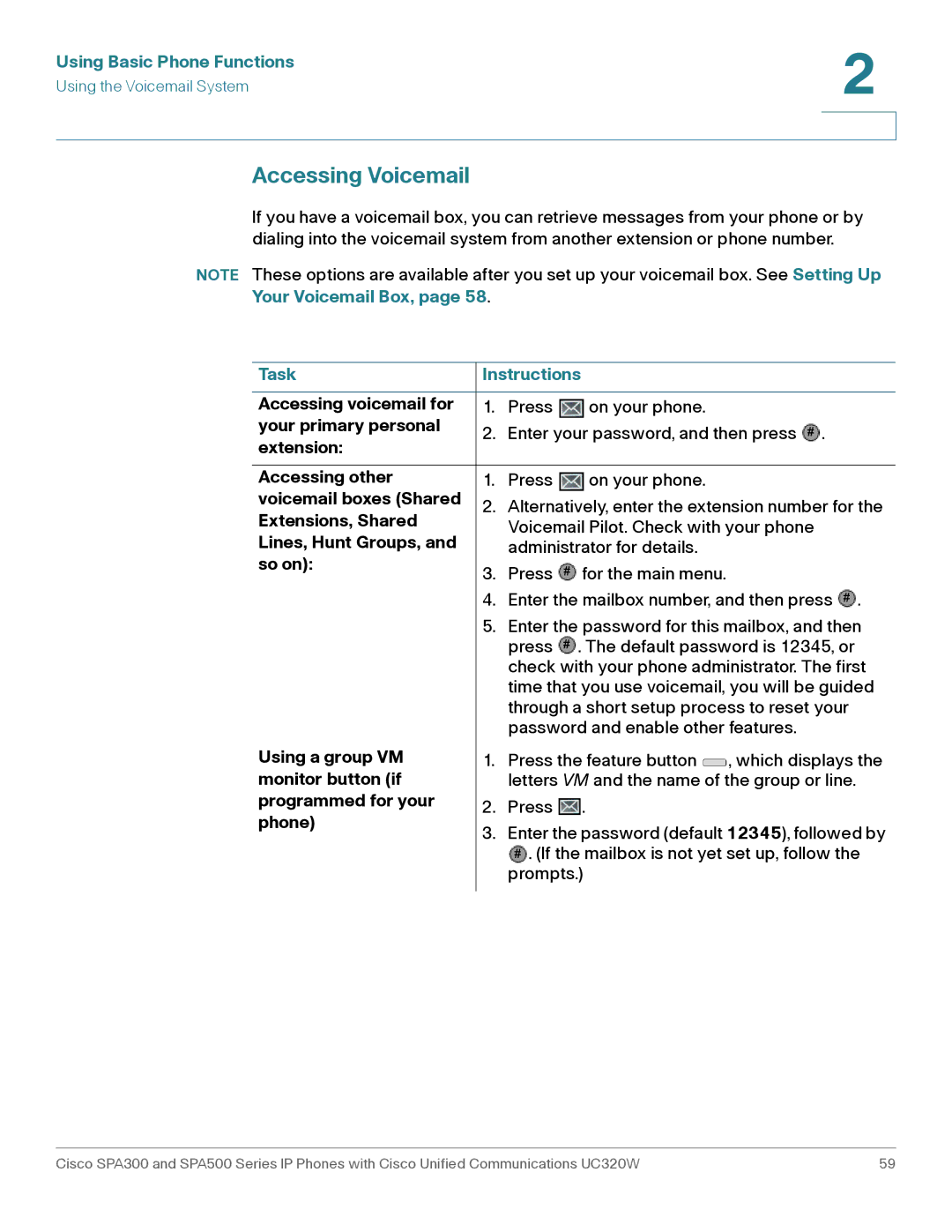User Guide
Cisco Systems, Inc. All rights reserv 78-19372-01C0
Getting Started
Using Basic Phone Functions
SPA501G
Using Advanced Phone Features
Appendix B Where to Go From Here
Contents
Appendix a Using an Analog Phone with the Cisco UC320W
Getting Started
Appendix A, Using an Analog Phone with the Cisco UC320W
Getting Started
Overview of the Cisco Small Business IP Phones
Model Comparison
Phone Features
Phone Components of Cisco SPA301
Phone Feature Description
To place the first call on hold and answer
Getting Started
Calls,
Using Personal Speed Dials,
More information, see Using Softkeys to Handle
See Using Your Line Buttons,
Cisco SPA501G,
Voice Response Menu on Cisco SPA301
Cisco SPA500S Attendant Console
Task Instructions
Connecting Wired and Wireless Headsets Optional
Bluetooth Profiles list
Select User Preferences Select Bluetooth Configuration
Devices in the Bluetooth Configuration
See Ignore
Using Softkeys to Handle Calls
Softkey Function
Transfer or Xfer
EditDial
Conflx
Or Conf Line
Dir or Directory
Dial . Also see Grpick or Grpickup
Shared Lines
Using Your Line Buttons
Extensions
Status Indicators
Using the Feature Buttons
Getting Started
Entering and Editing Characters
Editing a phone number
Alphanumeric mode
Input Num numeric
Entering letters
By entering a number on
Using the Setup Menu
Selecting a menu option
By scrolling
Using Basic Phone Functions
Your preferred audio device in this table
Using Basic Phone Functions
Choosing an Audio Device
Choosing your preferred audio device in this table
Select Preferences
Cisco SPA 525G2 With Your Bluetooth
Enabled Mobile Phone,
Adjusting Volume and Muting
Placing, Answering, and Managing Calls
Dial from a personal extension if allowed
Placing a Call
Placing a call
Redialing a number
Task Instructions
Number, see Forwarding All Calls,
Answering, Diverting, and Ending Calls
Managing Multiple Calls
Use the handset Lift it off hook
Using a Hot Phone
Using a Paired Phone
Directories,
Using the Intercom and Paging Features
Select Auto Answer
Select Preferences
Select User Preferences
Select Call Preferences
Transferring a call after Announcing it
Transferring Calls
Transferring a call Without announcing it
Line Monitor button
Using an Auto Dial Speed
Transferring a call by
Dial, Phone Monitor, or
See Editing an entry before dialing
Viewing and Returning Missed Calls
Select Miss Call Shortcut
Enabling or disabling Missed Call notification Softkeys
Calls to another number
All by using the softkey
Forwarding All Calls
Forwarding all incoming
Setting Do Not Disturb
Waiting Select User Preferences
Enabling or Disabling Call Waiting
Enabling or disabling Call
Waiting Select Preferences
Picking Up a Call for Another Extension
Parking a Call
Slot button
Call by using a call Park
Select Call Park Status
Parking and unparking a
Creating a Three-Way Conference Call
Cisco SPA525G/G2
Using the Phone Directories
See Entering and Editing Characters,
Using Your Contact List Personal Address Book
Characters,
Adding or editing a
Copy a contact record to Create a new entry
Using the Corporate Directories
Using the Call History Lists
Personal Address Book,
Editing Characters,
Setting or Changing a Phone Password
Logging on to your phone
Scroll to Device Administration and press
Setting Up Your Voicemail Box
Using the Voicemail System
Your Voicemail Box, Task Instructions
Accessing Voicemail
Option Description
Accessing your voicemail from an external number
Voicemail Options
Options to play messages
Press
Options to manage your messages
Options to manage your greetings and password
Using Advanced Phone Features
Blocking or allowing Caller ID by using Setup menu
Configuring Privacy Features
Using Advanced Phone Features
Also see Using Star Codes on Cisco IP Phones,
Scroll to Block Anonym Call
Blocking or allowing Anonymous calls by using Setup menu
Scroll to Dial Assistance
Enabling and Using Dial Assistance
Using dial assistance
Enabling or disabling dial Assistance
Creating and Using Personal Speed Dials
Creating a numeric
Using a numeric speed
Dial by using the keypad
Dial by using the Setup
Select LCD Contrast
Adjusting Your Display Screen
Adjusting the contrast
Adjust the brightness
Select Screen Preferences
Adjusting the backlight Timer
Configuring the Phone Screen Saver
Trigger Interval sec
Setting the timer for
Screen saver if enabled Select User Preferences
Scroll to Screen Saver Settings
Background Picture Displays a message
Adjusting the screen
Saver display if enabled Select Screen Saver Mode
Picture Rotation and Digital Frame
Saver display if enabled Select User Preferences
Enabled
Black Background , Gray Background , or
Select Ring Tone
Customizing the Ring Tones for Your Extensions
Contact List Personal Address Book,
Changing a ring tone
Enter To do this
Using Star Codes on Cisco IP Phones
Entering a star code manually
Pick up a ringing call from
Call waiting is disabled for
IVR Options Number
On the Cisco SPA501G Press
Number Option
Scroll to Network Configuration and press Select
Using Advanced Phone Features
Scroll to Bluetooth Configuration and press Select
Enabling Bluetooth
Wireless Headsets Optional section on
Initiating Pairing from the Cisco SPA 525G2
136
Select Personal Address Book
Making a Mobile Phone Call Using Your Cisco SPA 525G2
Receiving Mobile Phone Calls Using the Cisco SPA 525G2
Charging Your Mobile Phone Using Your Cisco SPA 525G2
Cisco SPA303 and Cisco
Changing the System Time Settings
Not available on Cisco SPA301 and Cisco SPA501G
Move the cursor to Set Current Time Manually
Cisco SPA525 and Cisco
Select Date/Time
Call
Basic Calling Functions on Analog Phones
Holding and resuming a
Using an Analog Phone with the Cisco UC320W
Using Star Codes for Special Features on Analog Phones
Using an Analog Phone with the Cisco UC320W
Using an Analog Phone with the Cisco UC320W
Cisco Small Business
Support
Product Documentation

